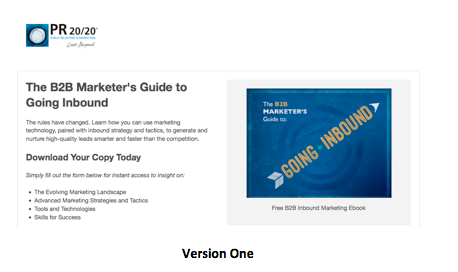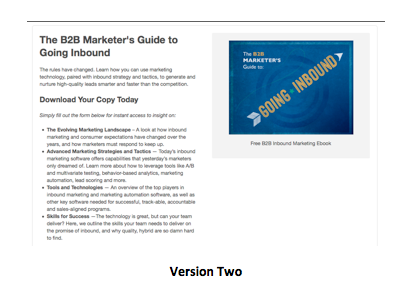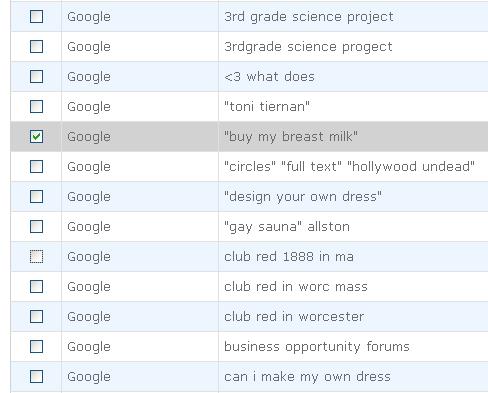In June 2012, PR 20/20 released the ebook, The B2B Marketer's Guide to Going Inbound, as a resource for marketers to generate and nurture high-quality leads through the use of technology, and inbound strategy and tactics.
The ebook was promoted within a blog post with calls to action to download by filling out a form on a separate landing page. To date, the ebook has been downloaded 262 times by marketers and agency professionals alike, driving significant leads to PR 20/20 and its sister site, Marketing Agency Insider.
Below we outline strategies employed and lessons learned during campaign execution.
Call-to-Action Tracking
Within the blog post, there were two calls to action prompting readers to download the ebook. The first was a text link that appeared above an image of the ebook cover. The second was a call-to-action button positioned at the end of the post.

We set up both links as separate events within HubSpot Enterprise so that we could better understand conversion rates and visitor behaviors.
Of the two, the text link was clicked 73.9% of the time, whereas the button was only clicked 26.2%. Our belief is that the text link was more popular because it appeared higher in the post, not necessarily because it was a text link. However, additional tests would need to be run to test that hypothesis.
A/B Test of Landing Page Copy
On the ebook landing page, we ran an a/b test that looked at the impact of copy length on conversion rates. In version one of the page, we included short bullets, outlining the ebook’s table of contents. In version two, we provided much more detail in those bullets. See the screenshots below to compare.

 As you’ll see, in both pages, copy length was the only variable that changed. Other factors, such as headline, image and form remained consistent.
As you’ll see, in both pages, copy length was the only variable that changed. Other factors, such as headline, image and form remained consistent.
After running the test for several months, we found that there was not a statistically significant difference in the two variations. Version one converted at 65.8%, whereas version two converted at 70.9%.
We have plans to run additional tests on this page in the future. In fact, we’re currently experimenting with HubSpot’s smart fields within the landing page form. Smart fields pre-populate information previously gathered from a user, eliminating unnecessary form fields, to make repeat conversions easy.
Targeted, Automated Lead Nurturing
In addition to optimizing CTAs and landing pages for conversion, it’s also important to think about the process that will occur after a lead submits a form.
Since our ebook was a thought leadership piece, in which people may not necessarily constitute a sales-ready lead for PR 20/20, we connected the form with an automated lead nurturing campaign.
In the form, we asked if the person’s company provided marketing services to clients.
 From here, we set up smart lists that automatically tag contacts as either a “company” or “agency” within our HubSpot portal. Audiences then receive tailored emails based on their status.
From here, we set up smart lists that automatically tag contacts as either a “company” or “agency” within our HubSpot portal. Audiences then receive tailored emails based on their status.
For example, companies get a set of three emails that offer additional resources, and then prompt the person to contact PR 20/20 for marketing support. Agencies, on the other hand, get one email that introduces them to Marketing Agency Insider, an educational site for agencies developed by PR 20/20.
By segmenting audiences in this way, and tailoring the message accordingly, we’ve seen strong email click through rates, and very few unsubscribes.
Key Takeaways
When working with calls to action and landing pages, the key is to have the systems in place that enable you to not only track performance, but also to make adjustments based on historical data. Keep in mind that in many cases, testing and optimization is an iterative strategy that can take time to execute properly. However, small updates collectively can drive a large impact.
Finally, we’ve found that the more targeted you can make the experience, the better. Technology, like smart lists, fields and CTAs, makes personalization easier than ever before.
Share your call to action and landing page experiences, best practices and lessons learned in the comments section below.
About the Author: Tracy Lewis is a consultant at PR 20/20, a certified Gold HubSpot partner and inbound marketing agency that combines content, public relations, social media and search marketing into integrated campaigns. She is also the community manager for Marketing Agency Insider.


